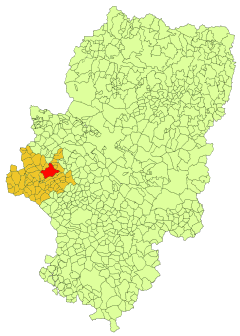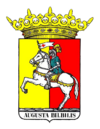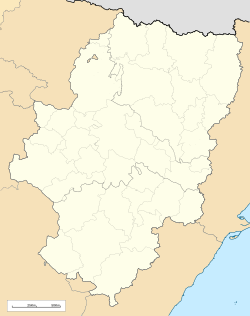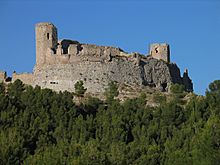Calatayud facts for kids
Quick facts for kids
Calatayud
|
|||
|---|---|---|---|
 |
|||
|
|||

Location in Aragon
|
|||
| Country | |||
| Autonomous community | |||
| Province | Zaragoza | ||
| Comarca | Comunidad de Calatayud | ||
| Judicial district | Calatayud | ||
| Area | |||
| • Total | 154 km2 (59 sq mi) | ||
| Elevation | 536 m (1,759 ft) | ||
| Population
(2018)
|
|||
| • Total | 20,035 | ||
| • Density | 130.1/km2 (337.0/sq mi) | ||
| Demonym(s) | Bilbilitano, na | ||
| Time zone | UTC+1 (CET) | ||
| • Summer (DST) | UTC+2 (CEST) | ||
| Postal code |
50300
|
||
Calatayud is a city in Spain. It is located in the Province of Zaragoza, within the region of Aragón. The city sits by the Jalón River, surrounded by the Sistema Ibérico mountains.
Calatayud is the second-largest city in its province, after the capital city of Zaragoza. It is also the biggest town in Aragón, apart from the three provincial capitals. The city is the main town of the Comunidad de Calatayud area.
The city's motto is "The very noble, loyal, always august and most faithful town of Calatayud". This shows its long and proud history.
Contents
Getting Around Calatayud
Calatayud is easy to reach by road and rail.
Roads Connecting Calatayud
The city is located near major highways. These include the Carretera Nacional N-II and the Autovía A-2. Other local roads also connect to the town.
Train Travel to Calatayud
The AVE high-speed train line stops in Calatayud. This line connects Madrid and Barcelona. Regular Renfe trains also stop here.
A Look at Calatayud's History
Calatayud has a very old and interesting past.
Ancient Beginnings
The city was first built by the Romans. They named it Augusta Bilbilis. This Roman settlement was founded on the site of an even older Celt-Iberian village. The famous poet Martial was born here around 40 CE. You can still see the ruins of Augusta Bilbilis about four kilometers north of the modern city.
Moorish Influence
The modern town of Calatayud was founded by the Moors. This happened around 716 CE, near the Ayyub castle. The name Calatayud comes from the Arabic words Qal‘at ’Ayyūb, meaning "the qalat (fortress) of Ayyub". People from the old Roman town moved to this new site.
Calatayud was important because it was located between central Spain and the Ebro valley. This made it a key city for many centuries.
Jewish Community and Reconquista
By the 11th century, a large Jewish community lived here. They stayed even after the reconquista, when Christian kingdoms took back land from the Muslims. However, they had to leave Spain in 1492.
Christian Rule and Mudéjar Art
Alfonso I of Aragón conquered the city from the Muslims in 1119. Even after this, Moorish styles continued to influence the area. Many churches in Calatayud show this mudéjar style. This is a unique art and architecture style that blends Christian and Islamic designs.
Later History
During the Peninsular Wars, in 1811, guerillas captured French-occupied Calatayud. The city was also the capital of its own province for a short time in 1822–23.
Important Places to See
Calatayud has many historic buildings and sights.
- Santa María Collegiate Church: This church has one of Aragón's most famous Mudéjar towers. It was built in the 15th century on the site of an old mosque. A beautiful Renaissance doorway was added in 1528.
- Santo Sepulcro Church: Built in 1141 and restored in 1613, this church was once very important to the Spanish Knights Templar.
- The Castle of Calatayud: This ancient fortress, or qalʿat, is the biggest and oldest of its kind on the Iberian peninsula.
- San Pedro Church: Founded by Ferdinand II of Aragón, this church was where the first parliament of Aragon was held in 1411.
What Calatayud's Economy is Like
Most jobs in Calatayud are in services, like shops and tourism. Agriculture is also very important. Farmers mainly grow apples and pears. There are also many vineyards in the area that produce wine.
Industry is not as big, but there are two industrial areas called La Charluca and Mediavega.
Local Areas and Villages
Calatayud includes several smaller areas and villages.
Quarters
- Huérmeda
- Torres
- Embid de la Ribera
Villages
- Campiel
- Carramolina
- Marivella
- Ribota
- San Ramón
- Terrer
Fun Festivals in Calatayud
The city celebrates several traditional festivals throughout the year.
- Easter: A religious holiday with processions.
- Pilgrimage in honor of el Cristo de Ribota: Held on May 1st.
- Saint Íñigo's Day: Celebrated on June 1st.
- Saint Roch's Day: A lively festival from August 14th to 16th.
- Virgen de la Peña: Celebrated from September 8th to 12th.
Sister Cities
Calatayud has special connections with four other cities around the world:
- Dueville, Veneto
 Italy
Italy - Gáldar, Gran Canaria
 Spain
Spain - Glen Ellyn, Illinois
 United States
United States - Auch, Gascony
 France
France
Images for kids
See also
 In Spanish: Calatayud para niños
In Spanish: Calatayud para niños








